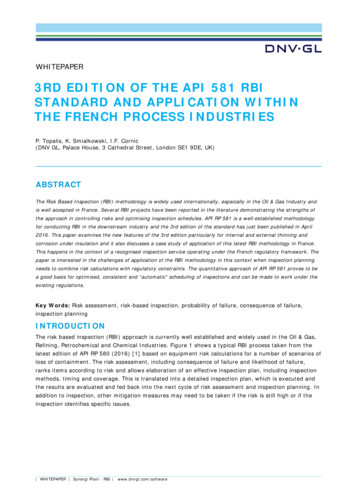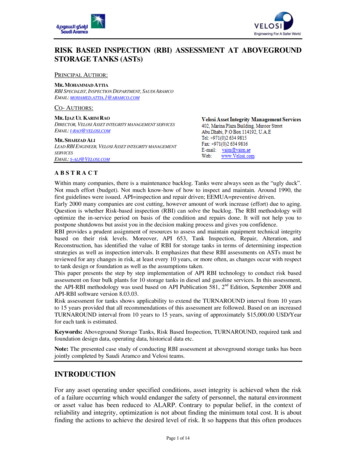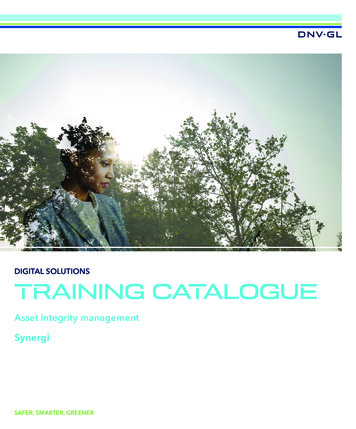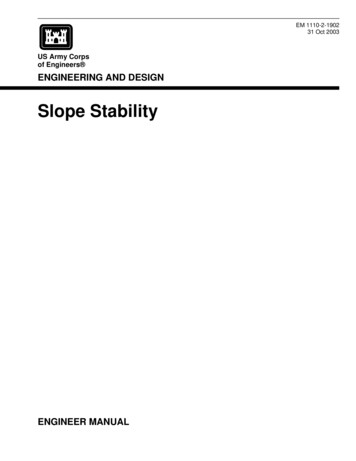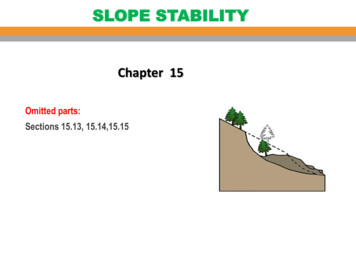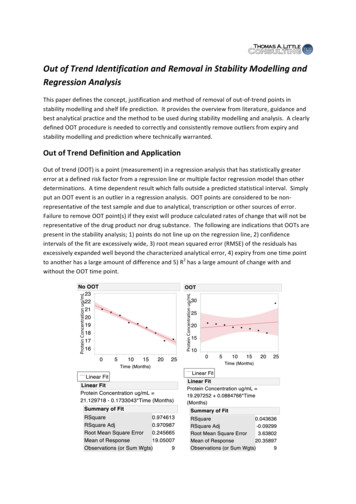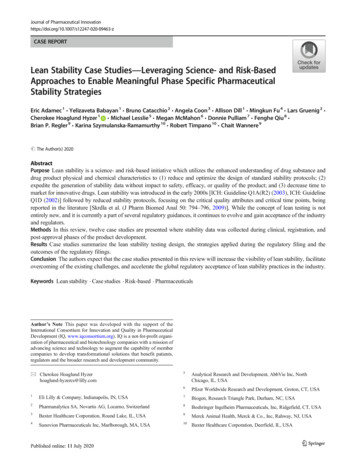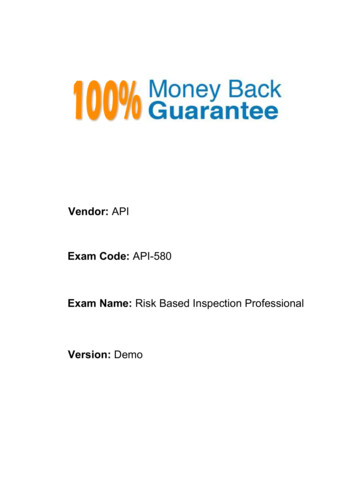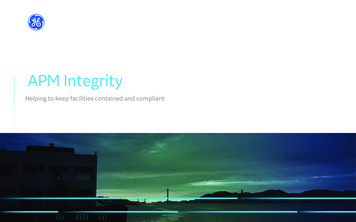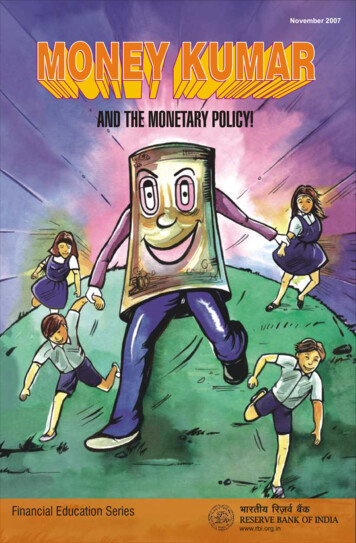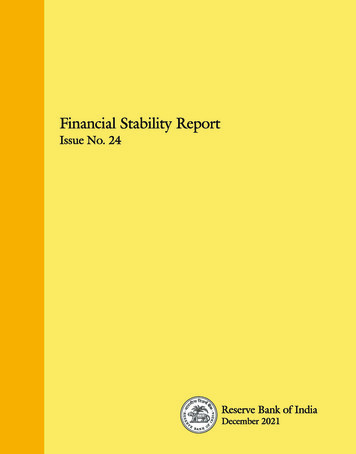
Transcription
Financial Stability ReportIssue No. 24Reserve Bank of IndiaDecember 2021
Reserve Bank of IndiaAll rights reserved. Reproduction is permitted provided an acknowledgment of the source is made.The publication can also be accessed through Internet at https://www.rbi.org.inFeedback of this report may be mailed to fsu@rbi.org.inPublished by Financial Stability Unit, Reserve Bank of India, Mumbai 400 001 and designed and printed atACME Packs & Prints (I) Pvt. Ltd., A Wing, Gala No.73, Virwani Industrial Estate, Goregaon - East, Mumbai - 400 063.
ForewordWe are now nearing two years of living with the pandemic. Many aspects of human life have been radicallyaltered. The world has witnessed tragic loss of lives and livelihood, but we have also learnt a lot and adapted.In this period of swings between hope and despair, the indomitable human spirit has prevailed and humanityhas undauntedly worked towards improving health and economic well being.Across the world, economic activity has endured the waves of pandemic, buffered by exceptional policysupport from governments, central banks and financial regulators. Challenges have also been brought on bysudden disruptions in supplies and logistics, shortages, job losses and destruction of businesses. The falloutof the pandemic on financial markets and institutions has been contained but the return to normalcy remainshesitant and uneven across regions and sectors.After the destructive second wave of the pandemic in India in April-May 2021, which interrupted aneconomic recovery that was gaining a foothold in the second half of 2020-21, the Indian economy is regainingstrength and resilience. Consumer confidence and business optimism are on the rise as the spread and scaleof vaccination expands. The outlook is progressively improving, though there are headwinds from globaldevelopments and more recently from Omicron. Entrenching the recovery hinges on revival of privateinvestment and shoring up private consumption, which remain below their pre-pandemic levels. Inflationremains a concern buffeted as it is by the build-up of cost-push pressures. Strong supply side measures tocontain food and energy prices have, however, worked towards moderating these risks.As highlighted in this issue of the Financial Stability Report, financial institutions in India have remainedresilient amidst the pandemic and stability prevails in the financial markets, cushioned by policy and regulatorysupport. Balance sheets of banks remain strong and capital and liquidity buffers are being bolstered to mitigatefuture shocks, as reflected in the stress tests presented in this report. In the spectrum of financial marketsthat leverage on technology for their functioning, the need for robustness of infrastructure, data security andthe soundness of rules and processes are of paramount importance, especially in the face of repeated andpotentially crippling cyber attacks.A strong, well-functioning and responsive financial sector fortifies the foundations of growth and thedevelopment of modern societies. While the pandemic induced bouts of volatility, spillovers and heighteneduncertainty are challenging, the Indian financial system has stood up well and remains well prepared tomeet the funding requirements of the economy. The process of capital augmentation and building up ofliquidity buffers by financial entities through a combination of instruments is proceeding apace and needs tobe sustained. The Reserve Bank of India remains resolute and committed in its endeavour to ensure a robustand efficient financial system that supports strong, sustainable and inclusive growth with macroeconomic andfinancial stability.Shaktikanta DasGovernorDecember 29, 2021
Financial Stability Report December 2021ContentsPage No.ForewordList of Select AbbreviationsOverviewi-iv1Chapter I : Macrofinancial RisksGlobal BackdropMacrofinancial Developments and OutlookOther Global Macrofinancial DevelopmentsCapital Flows and Exchange Rate VolatilityLondon Inter Bank Offered Rate (LIBOR) TransitionComodity MarketsPrivate Cryptocurrency RisksDomestic Macrofinancial RisksPublic FinanceGovernment Securities and Fixed Income Derivatives MarketsCorporate SectorExternal Sector Developments and Foreign Exchange Derivatives MarketsDomestic Equity MarketMutual FundsBanking Stability IndicatorBank CreditWholesale Bank CreditCredit flows to MSME SectorBanks’ Deposit ProfileResolution AnalysisMicrofinance SegmentNon-Banking Financial Companies (NBFCs)Consumer CreditHousing MarketSystemic Risk 4646Chapter II : Financial Institutions: Soundness and ResilienceScheduled Commercial Banks (SCBs)Asset QualitySectoral Asset QualityCredit Quality of Large BorrowersCapital AdequacyEarnings and ProfitabilityResilience – Macro Stress TestsSensitivity AnalysisBottom-up Stress Tests: Derivatives Portfolio48485051535454555964
ContentsPage No.Primary (Urban) Cooperative BanksStress TestingNBFCsStress Test - Credit RiskStress Test - Liquidity RiskInterconnectednessFinancial System NetworkContagion Analysis6567676970717177Chapter III: Regulatory Initiatives in the Financial SectorGlobal Regulatory Developments and AssessmentsLessons from the PandemicSystemic Resilience of Money Market Funds (MMFs)Pandemic Measures: Financial Stability ImplicationsOther International Regulatory DevelopmentsDomestic Regulatory DevelopmentsInitiatives from Regulators/AuthoritiesTransfer of Loan ExposuresSecuritisation of Standard AssetsCredit Risk Mitigation (CRM) for Derivative Transactions of Foreign Bank BranchesScale Based Regulation for NBFCsOpening of Current Accounts by BanksRetail Direct SchemeCustomer ProtectionIntegrated Ombudsman Scheme, 2021Default Fund (DF) of CCILFintechEnforcementSwing Pricing Framework for Mutual Fund SchemesOther DevelopmentsDeposit InsuranceCorporate Insolvency Resolution ProcessMutual FundsCommodity DerivativesCorporate Bond MarketCredit RatingsInsurancePension 0919192939494Annex 1: Systemic Risk Survey96Annex 2: Methodologies101Annex 3: Important Regulatory Measures116
Financial Stability Report December 2021Page No.LIST OF BOXES1.1An Assessment of the Uniform Price Auction Method201.2Term Structure of Volatility222.1Systemic Risk in the Banking Sector583.1Fintech Regulation in India – The Evolving Landscape88LIST OF CHARTS1.1Global Purchasing Managers’ Indices (PMI)41.2Goods Trade Barometer51.3Baltic Dry Index51.4Global Economic Surprise Index61.5Citi EM Asia Financial Conditions Index81.6Financial Conditions in Major Global Economies81.7Movement in AE and EME Currencies81.82-year Yield in Major Advanced Economies91.910-year Yield in Major Advanced Economies91.10G-7 Central Banks’ share of Government Debt and Issuances101.11Smoothed 2-year and 10-year US Treasury and OIS Spread101.12Term Structure - USD Swaption 3-year Rate Volatility101.13Growth Projections for Select Liability Classes of EBA Banks111.14US & Euro Area Select Mutual Fund Assets111.15AE Domestic Non-Banks’ Share of Government Debt and Issuances111.16Emerging Market Bond Flows and Portfolio Returns121.17Median Cross - Currency Basis swap: select EMEs121.18Portfolio Flows to Emerging Markets131.19Risk Perception of Investors131.20Brent Crude Spot and Futures – Price Trends141.21Daily Trading Volume for Brent Options at select Strike Prices151.22Bloomberg Commodity and Metal Indices151.23FAO Monthly Food Price Index151.24Investment in Commodity Linked Investment Funds151.25Repayment Obligations of Central Government – Dated Securities181.26Central Government Primary and Secondary Market Yields191.27Yield Curve Shifts between end-March 2021 and December 2021(up to December 13, 2021)191.28G-Sec and OIS Turnover201.29Market Risk in Overnight G-Sec Holdings211.30Sale of Listed Non-financial Private Companies - Growth23
ContentsPage No.1.31Operating Profit Margin - Listed Non-financial Private Companies231.32Operating Profit Margin – Listed Private Manufacturing Companies by Borrower Size241.33Leverage, Fixed Assets and Cash Holdings of Listed Private Manufacturing Companies241.34India’s Balance of Payments251.35Foreign Portfolio Investment251.36USD-INR and 3-month Historical and Implied Volatility261.37Currencies Against the US Dollar261.38Deliverable and Non-Deliverable Daily Forward Trade Turnover271.39Offshore Outstanding Forwards271.40MIFOR-OIS Spreads271.41INR Swaptions271.42Trend in Investments in the Equity Cash Segment281.431-year Forward P/E Ratio over 10-year Averages281.44Retail Participation in Equity Market (Ownership by Value)291.45AUMs of Open-ended Debt and Equity Funds291.46MF’s Investments in G-Sec /T-Bills/CBLO and Spread Products291.47Investor Profile of Debt Schemes291.48Investor Profile of Equity Schemes301.49Excess Return in Money Market Funds301.50Corporate Bond Holdings of Mutual Funds301.513-Year AAA Non-Financial Non-PSU Corporate YTM301.52Banking Stability Map311.53Credit Growth - SCBs311.54Exposure Distribution of Non-PSU Non-Financial Obligors331.55Long Term Loan Ratings331.56ECLGS Guarantees341.57Bank Group-wise ECLGS Guarantee351.58Run-Off Profiles of Deposits361.59Deposit profiles of PVBs371.60SLR Maintenance by Bank Groups371.61Delay in Initiation of Insolvency for specific Creditor Cohorts381.62Growth in Microfinance Portfolio391.63Microfinance Segment - Impairment401.64Bank Credit to NBFCs / HFCs411.65CP Issuances of Private NBFCs411.66Inquiry Volumes by Product Category431.67Inquiry Volumes by Lender Category43
Financial Stability Report December 2021Page No.1.68Growth in Credit Active Consumers431.69Inquiry Volume by Risk Tier441.70Approval Rates by Lender Category (per cent)451.71Growth in Outstanding Balances Across Lender Category451.72House Sales, Launches and Unsold Inventory461.73Unsold Inventory and Inventory Overhang462.1Deposit and Credit Profile of SCBs492.2New Loans by SCBs by Sector and Loan Type502.3Select Asset Quality Indicators512.4Sectoral Asset Quality Indicators522.5Select Asset Quality Indicators of Large Borrowers532.6Capital Adequacy542.7Select Performance Indicators of SCBs542.8Macroeconomic Scenario Assumptions for H2:2021-22 and H1:2022-23562.9Projection of SCBs’ GNPA Ratios562.10CRAR Projections572.11Projection of CET 1 Capital Ratio572.12Credit Risk - Shocks and Outcomes592.13Credit Concentration Risk: Individual Borrowers - Exposure602.14Credit Concentration Risk: Group Borrowers - Exposure602.15Credit Concentration Risk: individual Borrowers – Stressed Advances612.16Trading Book Portfolio: Bank-Group wise612.17Yield Curves and Shift in Yields Across Tenors since March 2021622.18HTM Portfolio - Composition632.19HTM Portfolio - Unrealised Gains as on September 30, 2021632.20Equity Price Risk642.21Liquidity - Risk Shocks and Outcomes642.22MTM of Total Derivatives Portfolio, Select Banks - September 2021652.23Impact of Shocks on Derivatives Portfolio of Select Banks652.24Credit Profile and Assets Quality Indicators of UCBs662.25Stress Test of UCBs672.26Sectoral Deployment of Credit672.27Share of Different NBFC Category in Gross Advances682.28Profile of P2P NBFCs682.29Profitability and Capital Adequacy682.30Sectoral GNPA of NBFCs692.31NBFCs’ Source of Funds69
ContentsPage No.2.32Borrowings by NBFCs’692.33Credit Risk in NBFCs – System Level702.34Bilateral Exposures between Entities in the Financial System712.35Network Plot of the Financial System - September 2021722.36Net Receivable ( ve) / Payables (-ve) by Institutions722.37Inter-Bank Market722.38Different Bank Groups in the Inter-Bank Market - September 2021732.39Composition of fund Based Inter-Bank Market732.40Network Structure of the Indian Banking System (SCBs SFBs SUCBs) – September 2021742.41Connectivity Statistics of the Banking System (SCBs)742.42Gross Receivable of AMC-MFs from the Financial Systems752.43Gross Receivable of Insurance Companies from the Financial System752.44Gross Payables of AIFIs to the Financial System762.45Gross Payables of NBFCs to the Financial System762.46Gross Payables of HFCs to the Financial System772.47Contagion Impact of Macroeconomic Shocks (Solvency Contagion)793.1Analysis of Aggregate Liquidity Buffer Maintained by Three Global Central Counterparties813.2Category of Complaints in Banking Ombudsman Offices863.3Domestic and International Commodity Futures Indices913.4Movement in Select Sectoral Indices in Commodity Derivatives913.5Commodity Derivatives Turnover at Exchanges923.6Fund Raised through Primary Market923.7Issuance of CPs and NCDs923.8Rating-wise Issuance of CPs and Listed NCDs933.9Category- wise Issuers and Subscribers of Corporate Bonds933.10Listed Debt Issues by Rating Actions933.11Distribution of Rating Downgrades – Sector-wise943.12First Year Premium Growth – Life Insurance943.13Growth in Total Premium - Life Insurance943.14NPS and APY Subscribers – Sector-wise943.15NPS and APY AUM-Sector-wise95
Financial Stability Report December 2021Page No.LIST OF TABLES1.1Growth Projection for 2021-20231.2General Government Fiscal Balance, 2019-26: Overall Balance1.3Cross-border Banking Flows to Non-Bank Entities of EMDEs1.4Percentage DV01 Contributed by RFRs – Currency Wise1.5US Reported RFR Linked Interest Rate Derivatives1.6CPI Inflation in Select Advanced Economies1.7Fiscal Indicators – Central Government1.8Market Borrowings by the Centre and States1.9Incremental Holdings of Dated G-Secs and SDLs: H1:2021-221.10 Dated G-Secs and SDLs – Investor Profile1.11 Bank Group - wise Incremental HTM Holdings, H1:2021-221.12 International Banking Flows to India1.13 Valuation Matrices1.14 Sectoral Share in Incremental Credit by SCBs1.15 Growth in Wholesale Credit to PSUs1.16 Aggregate Mobilisation of Funds1.17 Growth in Wholesale Credit to Non-PSU Non-financial Companies1.18 SMA Transition Matrix of Wholesale Portfolios - Non-PSU Non-financial Obligors December-19 to September-211.19 SMA Transition Matrix of Wholesale Portfolios - Non-PSU Non-financial Obligors June-21 toSeptember-211.20 Bank Credit to MSME Sector1.21 ECLGS Guarantee Disbursement1.22 Bank Group-wise Restructuring of MSME portfolio1.23 Bank Group-wise SMA Distribution of MSME Portfolio1.24 Borrowers Transition Matrix (September2020 – September 2021)1.25 Recovery Rates and Delay in Various Stages in a Select Sample of Cases Resolve betweenSeptember 2019 and September 20211.26 One-Year Transition Rate in Wholesale Substandard and Doubtful Assets1.27 NPA Composition of PSBs and PVBs Combined1.28 Asset Growth of Select NBFCs – A Segmental View1.29 Gross CP Issuances by Select NBFCs1.30 Weighted Average Maturity of Issuances of Select NBFCs1.31 Share of CP Outstanding in Aggregate Liability of Select NBFCs1.32 Intra-month CP Related Outflows1.33 Consumer Distribution by Risk Tier and Lender Category1.34 PSB Origination by Risk 38383940424242424444
ContentsPage 3.53.63.73.8Delinquency Levels in Aggregate Consumer Credit Across all Product CategoryScore Migration for Risk CategoriesDecline in System Level CRARTenor-wise PV01 Distribution of AFS PortfolioOOI - Profit/(loss) on Securities TradingTenor-wise PV01 Distribution of HFT PortfolioInterest Rate Risk – Bank-groups - Shocks and ImpactsLiquidity Risk in NBFCsContagion Losses due to Bank Failure – September 2021Contagion Losses due to NBFC Failure – September 2021Contagion Losses due to HFC Failure – September 2021SITG Ratios for Selected CCPsClaims Settled and Recovery of ClaimsDeposit Insurance PremiumDeposit Insurance Fund (DIF)Corporate Insolvency Resolution ProcessOutcome of CIRPs, Initiated Stakeholder-wise, as on September 30, 2021Growth in SIPs (FY: 2021:22)Segment-Wise Aggregate Turnover (Future Options)44456162626363707878788789898990909192
Financial Stability Report December 2021List of Select AbbreviationsAFSAvailable for SaleCDCertificate of DepositSTREuro Short-Term RateCET-1Common Equity bating the Financing forTerrorismAEsAdvanced EconomiesCGFDCentre's Gross Fiscal DeficitAIArtificial IntelligenceCIRPAIFIsAll-India Financial InstitutionsCorporate Insolvency ResolutionProcessAMC-MFsAsset Management CompaniesMutual FundsCMEChicago Mercantile ExchangeCMRCIBIL MSME RankAMFIAssociation of Mutual Funds in IndiaCOPConference of PartiesAMLAnti-Money LaunderingCPIConsumer Price InflationAPIApplication Programming InterfaceCPMIAPYAtal Pension YojanaCommittee on Payments and MarketInfrastructuresARCsAsset Reconstruction CompaniesCPsCommercial PapersARRsAlternate Risk-free RatesCRARCapital to Risk-Weighted Assets RatioAUMAssets Under ManagementCRAsCredit Rating AgenciesBCBSBasel Committee on BankingSupervisionCRILCCentral Repository of Information onLarge CreditsBIFRBoard for Industrial and FinancialReconstructionCRMCredit Risk MitigationCRRCash Reserve RatioBISBureau of International SettlementsDeFiDecentralised FinanceBoPBalance of PaymentDICGCBSEBombay Stock ExchangeDeposit Insurance and CreditGuarantee CorporationBSIBanking Stability IndicatorDIFDeposit Insurance FundCABCurrent Account BalanceDIIsDomestic Institutional InvestorsCASACurrent Account Savings AccountDPDDays Past DuesCBCentral BankEBAEuropean Bank AuthorityCBLOCollateralized Borrowings & LendingObligationECBEuropean Central BankCCCash CreditECLGSEmergency Credit Line GuaranteeSchemeCCBCross Currency BasisEMDEsCCILClearing Corporation of India LimitedEmerging Market and DevelopingEconomiesCCPsCentral CounterpartiesEMEsEmerging Market Economiesi
AbbreviationsESGEnvironmental, social andgovernanceIOSCOInternational Organisation ofSecurities CommissionsESRBEuropean Systemic Risk BoardIRACEXIMExport Import Bank of IndiaIncome Recognition and AssetClassificationFAOFood and Agricultural OrganisationIRDInterest rate derivativeFATFFinancial Action Task ForceIRDAIFBsForeign BanksInsurance Regulatory andDevelopment AuthorityFCsFinancial CreditorsISDAFDIForedign Direct InvestmentInternational Swaps and DerivativesAssociationFIMMDAFixed Income Money Market andDerivatives Association of IndiaLABsLocal Area BanksLBLarge BorrowersFPIsForeign Portfolio InvestorsLCHLondon Clearing HouseFRBsFloating Rate BondsLEFLarge Exposure FrameworkFSBFinancial Stability BoardLIBORLondon Inter-bank Offer RateFSDCFinancial Stability & DevelopmentCouncilMCXMulti-Commodity Exchange of IndiaMESMarginal Expected ShortfallFSRFinancial Stability ReportMFsMutual FundsFXForeign ExchangeMHPMinimum Holding PeriodGBIGlobal Bond IndexMIFORGDPGross Domestic ProductMumbai Interbank Forward OfferRateGESIGlobal Economic Surprise IndexMLMachine LearningGNPAGross Non-Performing AssetMMFsMoney Market FundsG-SecsGovernment SecuritiesMMMFsMoney Market Mutual FundsHFCsHousing Finance CompaniesMRRMinimum Retention RequirementHFTHeld for TradingMSFMarginal Standing FacilityHQLAsHigh Quality Liquid AssetsMSMEHTMHeld To MaturityMicro, Small and MediumEnterprisesIAISInternational Association ofInsurance SupervisorsMTMMark-To-MarketNABARDNational Bank for Agriculture andRural DevelopmentNARCLNational Asset ReconstructionCompany LimitedIBBIInsolvency and Bankruptcy Board ofIndiaIBCInsolvency and Bankruptcy CodeICInsurance CompanyNBFCNon-Banking Financial CompanyICEXIndian Commodity ExchangeNBFC-BLNBFC- Base LayerIFSCAInternational Financial ServicesCentres AuthorityNBFC-DNBFC- Deposit TakingNBFC-ICCIMFInternational Monetary FundNBFC-Investment and CreditCompanyii
Financial Stability Report December 2021NBFC-IDFNBFC- Infrastructure Debt FundOISOvernight Index SwapNBFC-IFCNBFC- Infrastructure FinanceCompanyOOIOther Operating IncomeOTCOver-the-CounterNBFC-MFINBFC-Micro Finance InstitutionsPATProfit After TaxNBFC-MLNBFC-Middle LayerPCAPrincipal Component AnalysisNBFC-NDNBFC-Non Deposit TakingPCRProvisioning Coverage RatioNBFC-P2PNBFC-Peer-to-Peer Lending PlatformsPDsPrimary DealersNBFC-ULNBFC- Upper LayerPFRDANBFInon-bank financial intermediationPension Fund Regulatory andDevelopment AuthorityNCDEXNational Commodity and DerivativesExchange LimitedPFsPension FundsPSBsPublic Sector BanksNCDsNon-Convertible DebenturesPVBsPrivate BanksNCGTCNational Credit Guarantee TrusteeCompany LimitedQEQuantitative EasingNCLTNational Company Law TribunalQIBsQualified Institutional BuyersNDFNon-Deliverable ForwardQIPsQualified Institutional PlacementsNDSINon-Deposit taking SystemicallyImportantRBIHRBI Innovation HubRDGRetail Direct GuiltNDTLNet Demand & Time LiabilitiesRFResolution FrameworkNeSLNational e-Governance ServicesLimitedRFRRisk Free rateRoAReturn on AssetNFBNon-Fund BasedRoEReturn on EquityNGFSNetwork for Greening the FinancialSystemRRBRegional Rural BanksRSRegulatory SandboxNHBNational Housing BankSARONSwiss Average Rate OvernightNIMNet Interest MarginSCBsScheduled Commercial BanksNNPANet Non performing AssetsSDStandard DeviationNPANon-Performing AssetsSDLsState Development LoansNPSNational Pension SchemeSEBINSENational Stock ExchangeSecurities and Exchange Board ofIndiaNSUCBsNon-Scheduled Urban CooperativeBanksSFBsSmall Finance BanksSIDBISmall Industries Development BankOf IndiaODOverDraftOECDOrganisation for EconomicCooperation and DevelopmentSIPsSystematic Investment PlansSITGSkin-In-the-GameOpen ended fundsSLRStatutory Liquidity RatioOEFiii
AbbreviationsSMASpecial Mention AccountSOFRSecured Overnight Financing RateSONIASterling Overnight Index AverageSPDsStandalone Primary DealersSPETReDSTrade Receivable and DiscountingSystemUCBUrban Cooperative bankSpecial Purpose EntityUPIUnified Payment InterfaceSRFSettlement Reserve FundVRRRVariable Rate Reverse RepoSRISystemic Risk IndicatorSRSSystemic Risk SurveyWALRWeighted Average Lending RateSUCBsScheduled Urban Cooperative BanksWTOWorld Trade OrganisationTONATokyo Overnight Average RateYTMYield to Maturityiv
Financial Stability Report December 2021OverviewThe Financial Stability Report (FSR) is publishedbiannually and includes contributions from all thefinancial sector regulators. Accordingly, it reflectsthe collective assessment of the Sub Committee ofthe Financial Stability and Development Council(FSDC-SC) on risks to financial stability.Macrofinancial RisksThe global recovery has been losing momentum inthe second half of 2021, impacted by resurgenceof infections in several parts of the world, supplydisruptions and bottlenecks, persistent inflationarypressures and shifts in monetary policy stancesand actions across systemic advanced economy(AE) central banks as also some emerging marketeconomies (EMEs). Tightening of global financialconditions, superimposed on elevated domesticinflation has roiled EMEs, in particular. TheUS dollar posted large appreciations vis-a-visEME currencies, which were also weakened bystubbornly rising energy prices. Capital flows toEME bond markets are showing signs of taperingoff and flowing out, while equity flows haveturned volatile. Realignment of interest rates inthe process of policy normalisation could lead todiscretionary shifts in portfolios among banks aswell as recalibration of banking sector liabilities.More recently, Omicron has cast a shadow on globaleconomic prospects.Domestic Economy and MarketsOn the domestic front, the second wave of thepandemic showed distinct signs of subsiding by July2021. Localised restrictions have been eased and theengines of growth have started revving up, aided byprogress in vaccination. During April-October 2021,all the deficit indicators of the central governmentexhibited improvement from their pre-pandemiclevels. The borrowing programme has proceededsmoothly. The Indian corporate sector has gainedstrength and resilience through the pandemic andkey financial parameters of listed non-financialprivate companies indicate improvement. Bankcredit growth is showing signs of a gradual recovery,led by the retail segment, although flow of creditto lesser rated corporates remains hesitant. Micro,small and medium enterprises (MSMEs) as also themicro finance segment are reflecting signs of stress.Financial Institutions: Soundness and ResilienceSCBs continued to bolster their capital - capital torisk-weighted assets ratio (CRAR) of SCBs reached16.6 per cent in September 2021 - and their returnon assets (RoA) and return on equity (RoE) weremaintained in positive territory. While the assetquality of banks showed improvement, with thegross non-performing assets (GNPA) and net NPA(NNPA) ratios declining to 6.9 per cent and 2.3 percent, respectively, their slippage ratio inched up inSeptember 2021. The provisioning coverage ratio(PCR) increased from 67.6 in March 2021 to 68.1 percent in September 2021.Macro-stress tests for credit risk show that SCBs’GNPA ratio may increase from 6.9 per cent inSeptember 2021 to 8.1 per cent by September 2022under the baseline scenario and to 9.5 per centunder a severe stress scenario. The stress tests showthat all banks would be able to comply with theminimum capital requirements even under severestress scenarios.The CRAR of urban co-operative banks (UCBs) stoodat 12.9 per cent in September 2021 while that ofNBFCs stood at 26.3 per cent.Network analysis indicates that the total outstandingbilateral exposures among constituents of thefinancial system have been on an upswing sinceH1:2020-21, with SCBs having the largest share of1
Overviewbilateral exposures albeit still below pre-pandemiclevels. In terms of inter-sectoral exposures, assetmanagement companies/mutual funds (AMCMFs), followed by insurance companies, remainedthe dominant fund providers in the system, whileNBFCs were the biggest receivers of funds, followedby housing finance companies (HFCs). A simulatedcontagion analysis showed that losses due to failureof the five banks with the maximum capacity tocause contagion increased in September 2021 visà-vis March 2021, but they would not lead to thefailure of any additional bank.Regulatory Initiatives and Other Developments inthe Financial SectorThe global regulatory environment continues toevolve and get refined in spite of the pandemic.Financial regulators are devoting attention todistilling the lessons learned from the pandemic,2analysing the ripple effects of rollback of policysupport measures and enhancing the resilienceof the financial system. On the domestic front,Government and financial sector regulatorscontinued with their efforts towards achieving asustainable recovery and enhancing the resilience ofthe financial system.Assessment of Systemic RiskIn the Reserve Bank’s latest Systemic Risk Survey(SRS), all broad categories of risks to the financialsystem – global; macroeconomic; financial market;institutional; and general – were perceived as‘medium’ in magnitude, but risks arising on accountof global and financial markets were rated higherthan the rest. Commodity prices, domestic inflation,equity price volatility, asset quality deterioration,credit growth and cyber disruptions were rated asthe major risks.
Financial Stability Report December 2021Chapter IMacrofinancial RisksThe global recovery is clouded by the emergence of the Omicron variant of COVID -19. Inflationary pressurespersist and monetary policy paths are diverging among major economies. On the domestic front, the recovery isregaining traction after the debilitating second wave of the pandemic. The corporate sector has displayed resilienceand bank credit growth is showing signs of a gradual recovery, led by the retail segment. Stress is, however, visibleamong micro, small and medium enterprises (MSME) and in the micro finance segment.Introduction1.1The emergence of Omicron as a COVID-19variant of concern in late November 2021 causedpanic to sweep across financial markets, triggeringthe worst ‘Black Friday’ plunge on record by the DowJones that reverberated worldwide. Bond yields andinternational crude prices turned volatile and therecent strength of the US dollar has been shaken.Fresh travel restrictions as well as quarantining andsocial distancing protocols have been imposed andcountries are on high alert to ascertain the efficacyof existing vaccines to the new mutation.1.2Even ahead of Omicron, global growth andtrade had begun to lose pace, stalled by formidableheadwinds from supply disruptions and bottlenecks,logistics dysfunctions, shipping charges and portcongestions as well as shortage in key intermediatesand personnel. These forces, along with elevatedcommodity prices, have rendered inflationarypressures persistent across geographies, posinga serious risk to global economic prospects. As anincreasing number of advanced economy (AE) centralbanks join their emerging market economy (EME)counterparts in either raising monetary policy rates orin telegraphing faster normalisation, global financialconditions have tightened and turned volatile.Retrenchment in capital flows across most EMEshave amplified currency depreciation among these1countries. Many of them are contending with largepandemic-induced losses of gross domestic product(GDP) and jobs that will take years to reclaim, evenif pre-pandemic levels are being sighted by some.Overall global demand has weakened, with worldGDP growth estimated to have lost a full percentagepoint in Q3:2021 on a sequential seasonally adjustedannualised basis. Overall, the near-term outlookremains clouded, with global growth projectionsbeing trimmed by multilateral agencies.1.3Looking ahead, an important factor thatis set to reshape the macroeconomic and financiallandscape is the impact of climate change and themitigating policy commitments at the Conferenceof the Parties – 26th United Nations Climate ChangeConference (COP-26) - towards environmentalresilience. Action on these assurances is beingprioritised by the recent intensification of naturalcalamities - floods in the United Kingdom; heatwavesand wildfires in the United States, Canada andAustralia; droughts in Brazil and higher frequencyof cyclones and unseasonal rains in various partsof India. The World Bank estimat
Dec 29, 2021 · 1.1 Global Purchasing Managers’ Indices (PMI) 4 1.2 Goods Trade Barometer 5 1.3 Baltic Dry Index 5 1.4 Global Economic Surprise Index 6 1.5 Citi EM Asia Financial Conditions Index 8 1.6 Financial Conditions in Major Global Economies 8 1.7 Movement in AE and EME Cu
